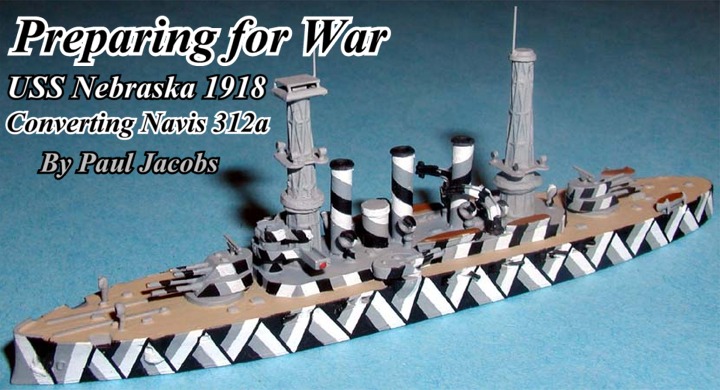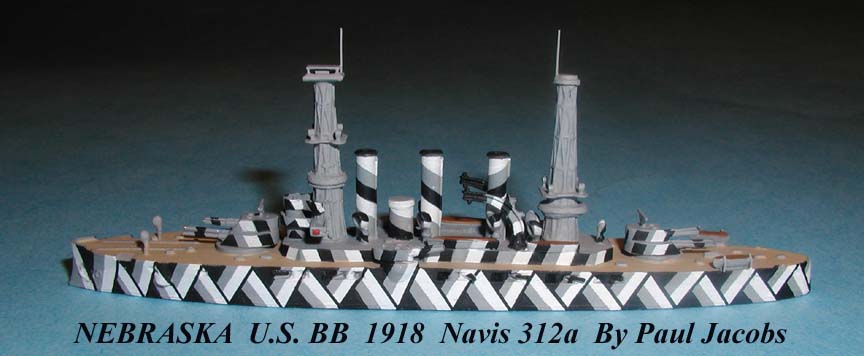 |
 |
Around 1909 the U.S. Navy began installing cage masts on its older battleships, including those of the VIRGINIA Class pre-dreadnoughts. The U.S.S. NEBRASKA was one of this class. In 1918 she had the distinction of being painted in the unique camouflage pattern shown here. This pattern was not created to hide the ship, but rather, as with most patterns, was intended to confuse range-finding.
Good photos of the pattern can be found on the Naval Historical Center site at: www.history.navy.mil In order to do the pattern, however, it is necessary to first modify the stock Navis model of the VIRGINIA (NM 312a). Primary changes include removal of the aft cage mast, and re-siting of it further forward, as on this particular ship it was closer to the aft most funnel than on some of it’s sister ships. Removal of the cage mast required removal first of the aft turret, then cutting at the base with a Dremel saw. The fighting tops of the cage masts must be modified, new searchlight platforms added, a structure placed between #1 and #2 funnels, and various other changes made, which can readily be seen in the photos. Other good sources of information include AMERICAN BATTLESHIPS 1886-1923, by Reilly and Scheina, Naval Institute Press, 1980. Once these changes have been made, one can get to the laborious task of doing this camouflage pattern, which was experimental, and was removed soon after the war’s end. Photos of the ship in mid-1919 show her once again in all over gray paint.
 |
One can do this job with paint alone, but I chose to use decals for the white stripes and the narrow black ones, as I felt this would be easier and faster. The stripes were cut from solid color decal sheets by Microscale. The black triangular shapes were painted on the hull. The deck was first painted using Polly Scale Aged Concrete. Then the hull was decaled with the white stripes, followed by the narrow black ones. The decals were melted into the gray paint using Solvaset, a setting solution that literally melt the decals into the paint. It is impossible to tell when finished that these are decals. The decals can be moved even when wet with the solution, so that final adjustments can be made in their positions. This whole process is tedious and time consuming, but not as difficult as it first appears. The pattern seems complicated and daunting, but once you get started, it follows an arrangement so regular, that I was able to complete it without constant reference to the photos.
The NEBRASKA had, as with most of the other U.S. battleships, a rather uneventful World War I career. Whether or not this particular pattern succeeded in it’s intended goal, I do not know. However, judging from how conspicuous the model is in my display case with other ship models, it certainly most have been one of the most visible ships at sea! A pattern reminiscent of this one, though less geometric, could be found in WW II on the French light cruiser GLOIRE.